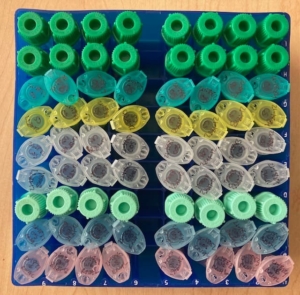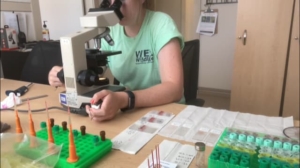This week I will be showing you all how I process my samples once I get back to the lab. Whole blood samples get processed as soon as I get back for the day, and swabs/plasma get frozen for further analysis once I get back to the lab in Urbana. Depending on the number of turtles we track in one day, the order in which I do things varies to ensure maximum efficiency. Check out the video to watch me process four of our turtle samples!

Box of samples! Each turtle gets its own column of labeled tubes
- Erythrocyte Sedimentation Rate (ESR): This is the very first thing that is done since it needs to sit for an hour before reading. Blood is drawn up in a capillary tube, sealed with clay on one end, and allowed to sit, undisturbed, for one hour. After the hour is complete, the distance between the top of the plasma and the top of where the red blood cells have settled is measured with small calipers and recorded.
- Blood Smears: These are the definition of practice makes perfect… A small drop of blood is placed on a labeled glass slide and then precisely smeared across with another slide for us to perform a complete blood count. Dr. Allender makes these look easy but trust me they are harder than they look. I have definitely gotten better as the summer has progressed which may or may not be why I waited so long to record myself making them…
- Hemocytometers: For this step, a small amount of blood is placed in phyloxine stain and left to sit for 10 minutes. After that, the sample is carefully loaded into the chambers of a hemocytometer slide and left to sit for an additional 10 minutes before reading.
 This loaded slide is placed under a microscope and the white blood cells (now stained a dark pink color) are counted in both chambers. I think in the office this is everyone’s least favorite step since they have to listen to the clicking of my cell counter for each sample (sorry guys!).
This loaded slide is placed under a microscope and the white blood cells (now stained a dark pink color) are counted in both chambers. I think in the office this is everyone’s least favorite step since they have to listen to the clicking of my cell counter for each sample (sorry guys!). - Packed Cell Volume (PCV): Since I brought a small centrifuge with me to Cape Cod, I have tiny microhematocrit tubes that are about half of the size of normal ones! Blood is drawn into these tubes via capillary action and the tubes are sealed with clay on one side. Two tubes are used per sample, and these are centrifuged before reading. The red blood cells are spun to the bottom of the tube and a scale is held up against these tubes to determine the % of red blood cells in the sample.
- Total Solids: A small drop of plasma is placed on a refractometer in order to evaluate the total solids/protein in the blood. The refractometer is held up to the light and the value can be interpreted from the scale on the visualization window.
- Plasma: Tubes of blood are spun down in a centrifuge to separate the plasma from the blood cells. This plasma is then drawn up with a pipette and separated into Eppendorf tubes labeled for plasma electrophoresis (EPH), chemistry, and bank.
After all the samples are processed and placed in the freezer, the probes I used for the day are disinfected, more tubes are pre-labeled, and supplies are restocked in my backpack to tackle another day of turtle tracking. Tune in next week for more turtle content and to see which SURPRISE guest is in Cape Cod!
Total Turtle Count = 124
